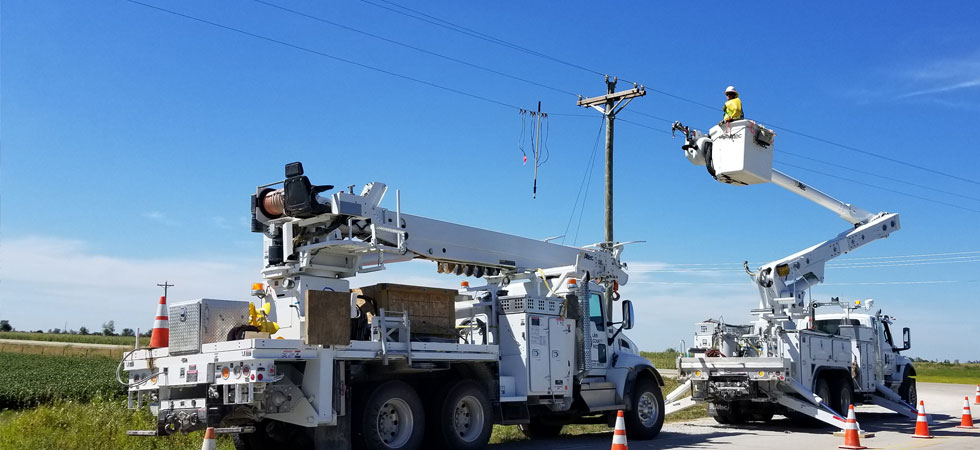Outage Resources
How is Power Restored
Immediately after a severe storm hits the Linn County REC service area, crews begin to assess the extent of the damage and the Cooperative puts its emergency power restoration plan into action. The plan is designed to restore power to the greatest number of members in the shortest amount of time. The severity of the outage and weather conditions always play a role in the time it takes to restore power.
When a storm strikes, crews immediately begin the restoration process. Learn more about how power is restored in the graphic below:
What Causes Outages
WEATHER: Weather events are the leading cause of power outages. High winds, lightning strikes, snow, and ice can cause major damage to electrical equipment.
ACCIDENTS: Have you ever experienced a power outage on a sunny day? It could have been caused by a vehicle accident. Contractors digging into our power lines during excavation work can also cause power disruptions.
CRITTERS: They cause outages more than you probably think. Squirrels, birds, snakes, and other small animals can inadvertently contact power lines and other electrical equipment, causing short circuits and service disruptions. That’s why we do our best to safeguard equipment to keep them out.
MAINTENANCE: We periodically conduct maintenance and repairs to improve the reliability of our system. Occasionally, we may need to shut off power in the affected work areas. Scheduled outages are typically short and help ensure our crews’ safety while they work – and we’ll always let you know about these outages in advance.
Power Blinks
Have you ever come home to find your digital clocks flashing "12:00"? It's caused by a power blink – a brief interruption that's designed to prevent a longer power outage.
Blinks occur when an obstruction, like a tree limb, comes into contact with a power line or transformer. To prevent damage to the utility system or your home, a circuit breaker interrupts the electricity for a fraction of a second.
If you are experiencing power blinks, please call our office at 319-377-1587 to speak with our Operations Department.
Service Facilities - Who Owns What
If a storm damages any equipment owned by the co-op, we are responsible for repairs. If a storm damages any member-owned equipment, the member is responsible for repairs. Members should hire a licensed electrician when making any repairs to member-owned equipment.
- Meter loop (on meter pole): owned by the membe
- Meter pole: maintained by Linn County REC
- Wires from meter pole to house or farm facilities: owned by the member
- Meter: owned by Linn County REC
- Fuse/breakers (below the meter): responsibility of the member
Who Owns What (graphic) Meter on pole/pedestal
Storm Safety
Before the Storm
- Keep emergency numbers, including Linn County REC’s, available and always have a corded or cellular phone in your home. Cordless phones will not work during a power outage.
- Keep a battery operated flashlight, radio, clock, and extra batteries on hand.
- Know where your main breaker disconnect is.
- Unplug sensitive electrical equipment.
During the Storm
- Report your outage to us by calling 319-377-1587 or toll free in Iowa at 1-800-332-5420. You can also report and check your service status through our SmartHub app.
- Unplug as many appliances as possible. This will prevent damage from a power surge that may occur during power restoration.
- If outside, don’t touch or drive over a power line. Always assume a downed line is energized.
After the Storm
- If you have unplugged appliances, plug them back in one at a time once power has been restored.
- If you see a downed line or damaged utility equipment, contact us immediately. Make sure to keep people away. Always assume a downed line is dangerous, even if it’s not jumping or sparking.
- Do not attempt to assist utility crews. What may seem like help can actually hamper restoration and safety efforts.
Resetting Circuit Breakers
- Disconnect lamps and appliances in use when circuit went out and make sure your hands are dry; stand on a dry board or rubber pad, if possible.
- To determine which breaker is tripped, look for a breaker in or near the OFF position.
- Push handle past OFF position (you may have to do this twice).
- Return handle to ON position
How to Change a Fuse
- Disconnect lamps and appliances in use when circuit went out.
- Make sure your hands are dry; stand on a dry board or rubber pad, if possible. Open main switch, or pull-out section of panel labeled "main" in the service entrance, to cut off current while working at the branch circuit box.
- Identify the blown fuse. When a fuse blows, the transparent section becomes cloudy or blackened.
- Replace the blown fuse with a new one of proper size. The smaller sizes screw in and out just like light bulbs. If the blown fuse is a cartridge type, located in the pull-out section. It can be removed and replaced by hand pressure.
- Close the main switch, or replace pull-out section, to restore service.
- Throw away the blown fuse
Food Safety
If your home’s power is interrupted for two hours or less, losing perishable foods shouldn’t be a concern. When an outage is prolonged, it’s time to decide when to save and when to toss food away.
Use these food safety tips to help you minimize food loss and reduce the risk of foodborne illness:
- Throw away food that’s been exposed to temperatures above 40 degrees F for two hours or more.
- An unopened refrigerator keeps food cold for about four hours; food in a full freezer stays safe for about 48 hours.
- Refrigerated Food Safety Guidelines
- Frozen Food Safety Guidelines
Remember the American Red Cross food safety rule: “When in doubt, throw it out.”
